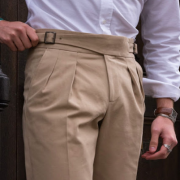Cufflinks were only designed to be worn on shirts with buttonholes on both sides of the cuff, but no buttons.
It is therefore a decorative fastener for sleeve ends, worn by both women and men on a dress shirt or blouse.

A brief history:
Although cufflinks, or rather cuff- cuff strings, remained popular well into the 19th century, it was during the reign of Louis the XIV that shirt sleeves were closed with 'boutons de manchette', or "sleeve-knots". Typically, these were identical pairs of coloured glass, connected by a short chain.
Around 1715, the polished glass gave way to pairs of two decoratively painted or decorated studs, often in diamonds, connected with decorated gold links. So this was the birth of the cuff-'button', whether in simple glass, or a worked (precious) metal button or jewel.

The cuff itself can be either single or double in length. The double ones, called 'French cuffs' are, as the name suggests, folded in half. They are either 'kissing', with the ends pinched together, or 'barrel-style' where one piece overlaps the other.
The pinched version is usually preferred.
Nowadays we see many variants in design. The most simple consist of a bar or chain that connects two discs. Since we are now back to wearing elegant dress shirts, the double cuffs have also returned. And they need cufflinks!
Raphaël van den Poel, former fashion consultant for Scapa ,Reinhard Frans and Atelier NA tailored suits,
writes our weekly blog on gentleman matters. He writes for MYX Magazine, a Flemish luxury lifestyle platform.
He also has his own blog which you can read here: http://belgiandandy.blogspot.com

Raphaël van den Poel The Belgian Dandy








